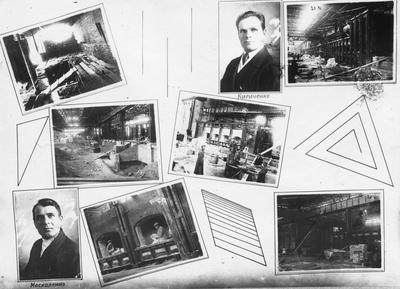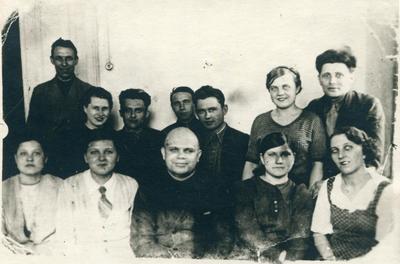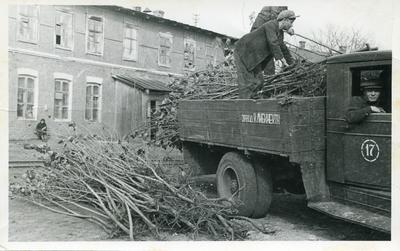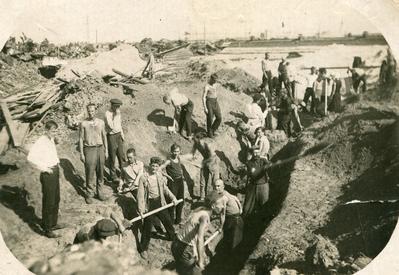
Photo collage. Construciton of new pipe shop. Lower Dnieper Pipe Rolling Plant
- ID: 5228
- Place: Dnipro
- Date: 1934
"The photograph shows employees of the Karl Liebknecht State Steel Mill in Katerynoslav (now PJSC “Interpipe Lower Dnieper Pipe Rolling Plant.”) The plant arose as a result of a merger between the “Charles and Gustave Chodoir” comapny and Bernard Hantke’s nailery. The plant was in the property of the “Society for Russian Iron Industry”. As of 1913 the enterpirse employed 1300 employees. The company produced seamless pipes, wire, nails, rivets, bolts, screws, springs, etc. When the First World War broke out in 1914, the factory, which had belonged to a joint stock company whose shareholders had German roots (Bernard Hantke), was nationalized by the government of the Russian Empire as “property of citizens of a hostile state.” The company’s lobby began exhibiting a sign “B. Hantke’s Sequestered Lower Dnieper State Plants.” During the war, the plant produced details for artillery shells, hand grenades, wire cutters and other types of military goods. In 1917-1920 the enterpirse found itself in dire straits, with production nearly stopping. The plant began to bounce back in 1920. The 1920s saw the establishment of a design department, an accounting and financial service, a capital construction, chief mechanic, and chief power engineer offices. In 1922 the plant was given the name of the German revolutionary Karl Liebknecht; the full name of the enterprise was now “the Karl Liebknecht State Steel Mill in Katerynoslav.” Late in 1922 the plant opened a literacy school. In 1923 the plant opened a “worker’s leisure club,” which was quite popular among the employees. 1924 saw the renovation and launch of a pressing department, which started making rivtes, bolts, washers and rings. The plant’s equipment underwent significant modernization in 1925: 10 up to date nail machines were acquired, and work on starting production of pipes began. An open hearth shop was launched in 1931, while in 1932 the old pipes shop became the first in the USSR to make drill pipes. As of 1933, 7020 workers, 460 engineering and tech-support, and 342 officials were employed at the plant. 118 workers and 836 trade school students were being trained in various professions directly in the shops. “Bolshevik,” the plant’s paper had this to say about the plant’s achievements as of 1934: “The first five-year period of growth was marked by reconstruction, an increase in pipe production; shop productivity was brought to 23,000 tons of pipes per year. A new open hearth shop – one of the best of its kind – was built. A cylinder shop was launched, with an annual capacity of 225 000 units. The start of the second Five-Year Plan finds the plant at work on further improving the pipe shop. The productivity of the shop has been increased to 45 000 tons. Construction of a shop for making 10-12-inch seamless pipes started in 1932; its capacity is 100 000 tons. Construction of a railway solid wheel shop (with the highest capacity in the world at the time) began in 1933. Open Hearth No. 4 was launched in 1934. Construction of a 100-ton open hearth is nearing conclusion.” In 1935 the first wheel shop in the USSR was launched at the plant. The plant’s paper, “The Bolshevik,” wrote on the occasion: “To this day the railways have been using composite wheels with separate tires. The solid wheel shop under construction in our plant is the first wheel shop of the Soviet Union, and will be the most powerful shop in the world in terms of production capacity. It will produce 100 000 tons of wheels per year. All of the labor-intensive operations at furnaces, presses and the rolling mill are highly mechanized, and thus the hard work of employees have been replaced with machine work. Thus, at full capacity, our three-shift staff will not exceed 100 people.” Today the company is known as “Interpipe Lower Dnieper Pipe Rolling Plant.” The plant is one of the largest producers of steel pipes of various functions, rail wheels, tires, and large-scale circular products. The photograph shows employees of the Karl Liebknecht State Steel Mill in Katerynoslav (now PJSC “Interpipe Lower Dnieper Pipe Rolling Plant.”) The plant arose as a result of a merger between the “Charles and Gustave Chodoir” comapny and Bernard Hantke’s nailery. The plant was in the property of the “Society for Russian Iron Industry”. As of 1913 the enterpirse employed 1300 employees. The company produced seamless pipes, wire, nails, rivets, bolts, screws, springs, etc. When the First World War broke out in 1914, the factory, which had belonged to a joint stock company whose shareholders had German roots (Bernard Hantke), was nationalized by the government of the Russian Empire as “property of citizens of a hostile state.” The company’s lobby began exhibiting a sign “B. Hantke’s Sequestered Lower Dnieper State Plants.” During the war, the plant produced details for artillery shells, hand grenades, wire cutters and other types of military goods. In 1917-1920 the enterpirse found itself in dire straits, with production nearly stopping. The plant began to bounce back in 1920. The 1920s saw the establishment of a design department, an accounting and financial service, a capital construction, chief mechanic, and chief power engineer offices. In 1922 the plant was given the name of the German revolutionary Karl Liebknecht; the full name of the enterprise was now “the Karl Liebknecht State Steel Mill in Katerynoslav.” Late in 1922 the plant opened a literacy school. In 1923 the plant opened a “worker’s leisure club,” which was quite popular among the employees. 1924 saw the renovation and launch of a pressing department, which started making rivtes, bolts, washers and rings. The plant’s equipment underwent significant modernization in 1925: 10 up to date nail machines were acquired, and work on starting production of pipes began. An open hearth shop was launched in 1931, while in 1932 the old pipes shop became the first in the USSR to make drill pipes. As of 1933, 7020 workers, 460 engineering and tech-support, and 342 officials were employed at the plant. 118 workers and 836 trade school students were being trained in various professions directly in the shops. “Bolshevik,” the plant’s paper had this to say about the plant’s achievements as of 1934: “The first five-year period of growth was marked by reconstruction, an increase in pipe production; shop productivity was brought to 23,000 tons of pipes per year. A new open hearth shop – one of the best of its kind – was built. A cylinder shop was launched, with an annual capacity of 225 000 units. The start of the second Five-Year Plan finds the plant at work on further improving the pipe shop. The productivity of the shop has been increased to 45 000 tons. Construction of a shop for making 10-12-inch seamless pipes started in 1932; its capacity is 100 000 tons. Construction of a railway solid wheel shop (with the highest capacity in the world at the time) began in 1933. Open Hearth No. 4 was launched in 1934. Construction of a 100-ton open hearth is nearing conclusion.” In 1935 the first wheel shop in the USSR was launched at the plant. The plant’s paper, “The Bolshevik,” wrote on the occasion: “To this day the railways have been using composite wheels with separate tires. The solid wheel shop under construction in our plant is the first wheel shop of the Soviet Union, and will be the most powerful shop in the world in terms of production capacity. It will produce 100 000 tons of wheels per year. All of the labor-intensive operations at furnaces, presses and the rolling mill are highly mechanized, and thus the hard work of employees have been replaced with machine work. Thus, at full capacity, our three-shift staff will not exceed 100 people.” Today the company is known as “Interpipe Lower Dnieper Pipe Rolling Plant.” The plant is one of the largest producers of steel pipes of various functions, rail wheels, tires, and large-scale circular products. "



